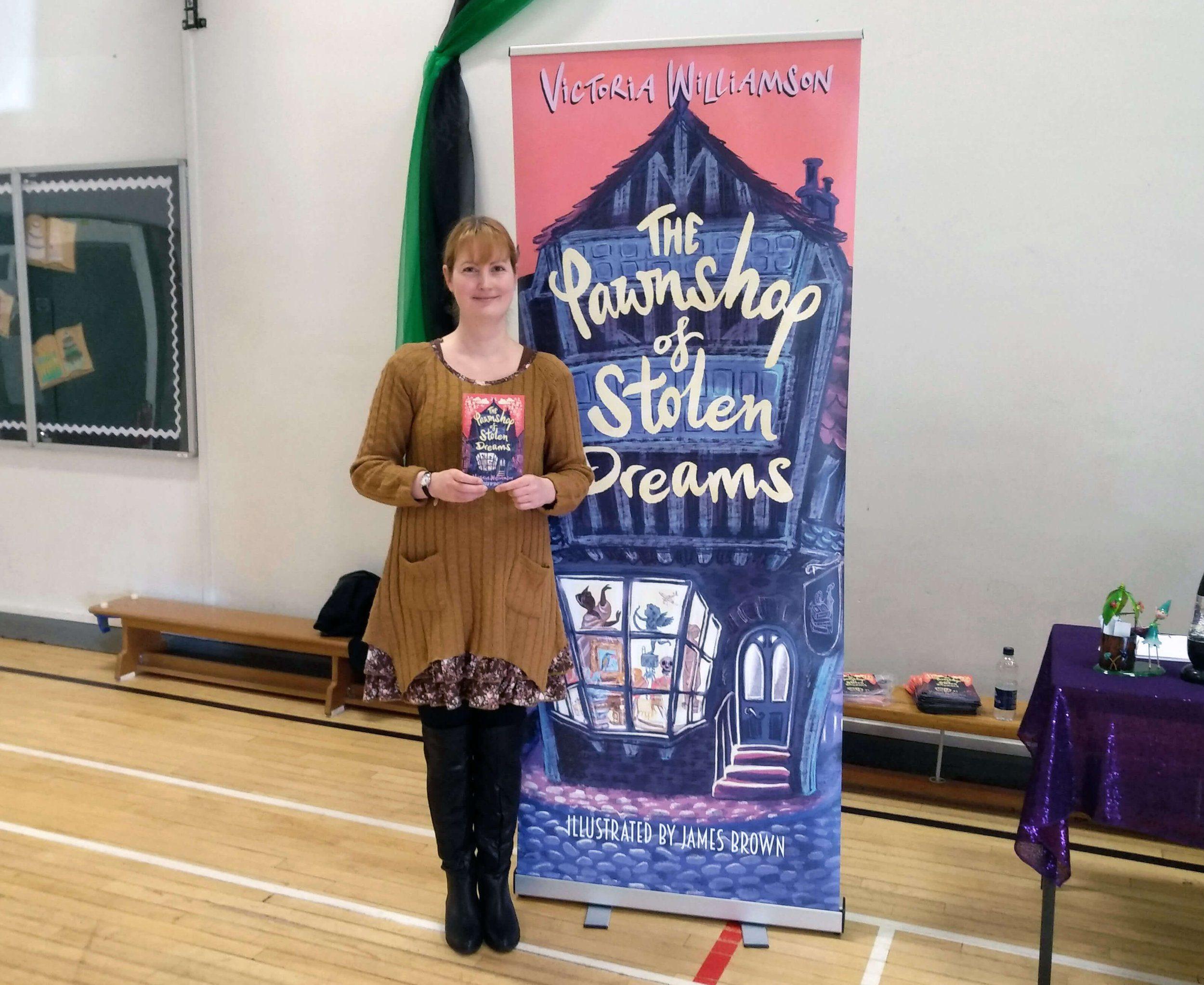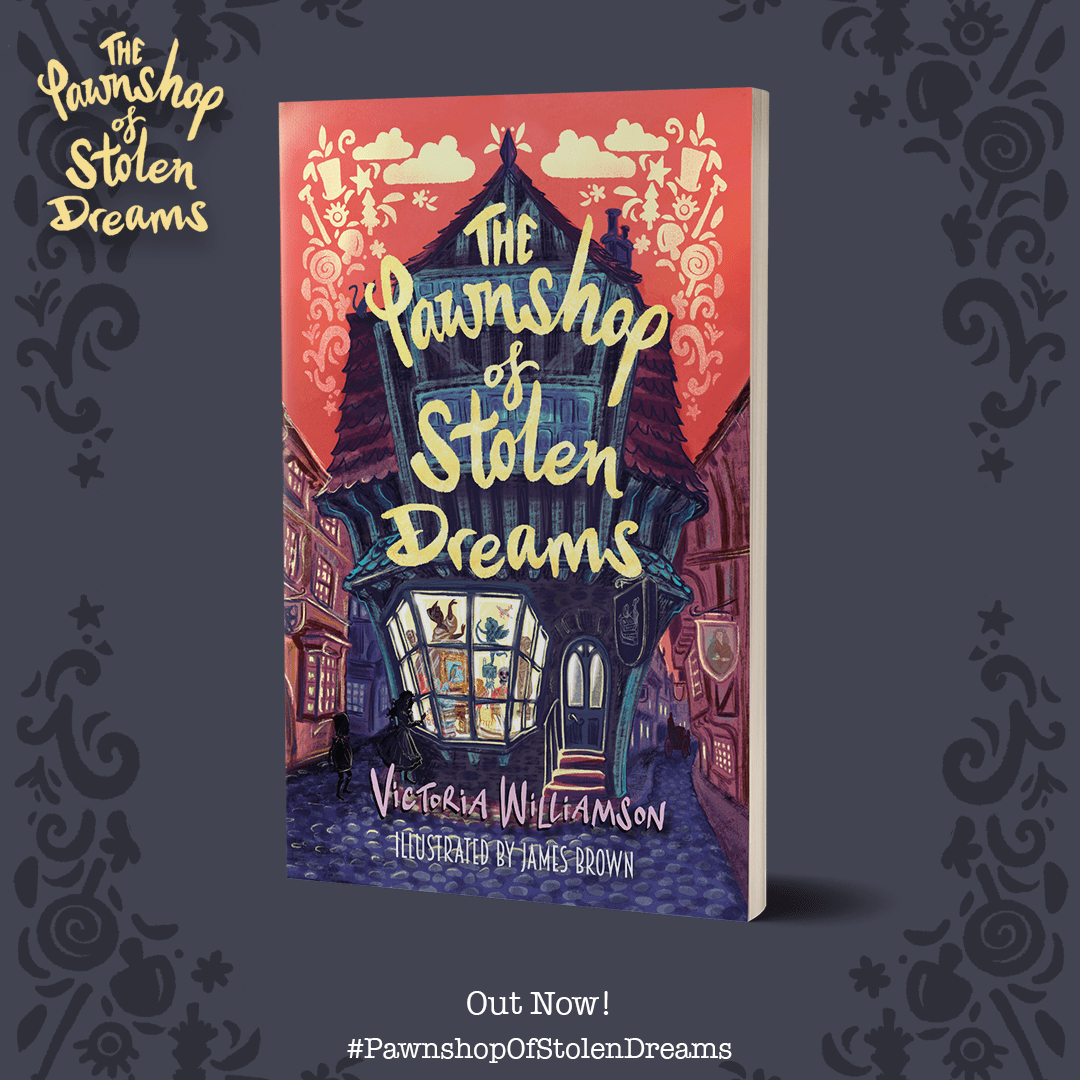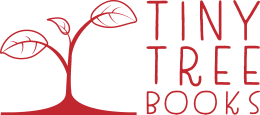
Discover how school days, Scottish folklore, and Gothic fiction inspired ‘The Pawnshop of Stolen Dreams’ with award-winning children’s author Victoria Williamson.
Victoria Williamson is an award-winning children’s author whose enchanting new book, ‘The Pawnshop of Stolen Dreams’ has already captured the imaginations of readers young and old.
In this interview, we delve into the stories that inspired a young Victoria to begin writing stories of her own (there are a few examples scattered throughout this piece), journey into Witchetty Hollow, the magical new world Williamson has created, and discover how the story’s hero, Florizel, mirrors the author herself. We also discuss the more mature themes of ‘The Pawnshop of Stolen Dreams’, and unravel the author’s fascination with ghost stories, Scottish folklore, and the allure of Disney’s darker films. Plus, we find out what’s to come for Victoria for the rest of the year.
‘The Pawnshop of Stolen Dreams’ is available now from all good bookshops. Order your copy here.
What can you tell us about writing The Pawnshop of Stolen Dreams? What inspired you to write this book?
I’ve always loved children’s books and films which have a bit of a gothic fairytale feel to them, along with a large helping of humour and a sprinkle of magic. One of the early reviewers described The Pawnshop of Stolen Dreams as ‘Willy Wonka’s Chocolate Factory meets Chitty Chitty BangBang via A Nightmare Before Christmas and Coraline’ which I thought was quite apt!
I drew much of my inspiration from my love of Tim Burton’s films, Roald Dahl’s books, and film scenes that really stuck in my head as a child, such as the Child Catcher’s horse and carriage, which became Storkhouse Services’ coach in this book. Usually, my novel ideas take a long time to formulate into full-length stories, but this one seemed to pop into my head almost fully formed. It took a lot less time to write than usual as well – almost as though it was writing itself (which was wonderful, but also a little spooky!). I think if you can tap into all of your childhood inspirations for your stories, then the characters and settings will be so much fun to write that it doesn’t seem like hard work, which was certainly true of this book.
You clearly love writing for the 8-12-year-old audience. What is it that drew you to writing middle-grade novels in the first place?
I’ve known I wanted to be an author ever since I was five years old. As a teenager, I thought I was going to be a writer of fantasy, science fiction, ghost stories, and horror books for adults, and a lot of the ideas I worked on at that time were in those genres.
I think it was the publication of the Harry Potter books that reminded me how much I loved children’s fiction, and I began concentrating more on that side of writing. There’s so much scope in middle grade to create magical worlds, fantastical creatures and places, and satisfyingly wicked villains who get their comeuppance, that I think it can be less restrictive than some other genres.
One of the things I enjoy most about writing middle-grade fiction is going on regular school visits and meeting children who are just as passionate about reading and writing as I was at their age. It’s lovely to know that some of them are going to grow up to be the authors of the future, and to get a chance to play a part, however small, in helping to inspire them to achieve those dreams.
Is The Pawnshop of Stolen Dreams the kind of book you’d have loved to have read at that age?
Hmm, it seems a little big-headed to say ‘yes’ to that question! I’ll stick with ‘I hope so’.
I hope ten-year-old me would have enjoyed reading it, but I can say for certain that ten-year-old me would have been thrilled to know that I definitely did grow up to be an author! When I was that age, I had a huge range of genres that I loved reading, so I read all the adventure stories, mystery stories, ghost stories, science fiction, and fantasy stories I could get my hands on, then I went straight back to our local library for more.
One thing I definitely would have loved about this book at that age is the illustrations done by the very talented James Brown. I was a very big fan of the Dorrie the Little Witch books as a child, and the illustrations really brought the stories to life. I was very impressed by the way that James managed to capture the characters and settings in The Pawnshop of Stolen Dreams, and the amazing cover he did would have jumped right out of the bookshelves at me if I’d seen this book in the library as a child!

There’s a magical spookiness to The Pawnshop of Stolen Dreams that I love. Have you always been a fan of the darker side of fantasy?
Absolutely!
I think that influence came from my love of horror and ghost stories as a teenager. I still write ghost and horror stories for adults, and sometimes that seeps through into my children’s work, particularly the books I write which are set at Halloween.
That seems to be the time of year that I’m most drawn to, as four of my books have been set at Halloween depicting everything from ‘Samhain’ in Roman Scotland, the witches in ‘Tam o’ Shanter’ by Robert Burns, to modern day Halloween parties, and the strange goings-on in Witchetty Hollow in the depths of autumn. There’s something about the mist-filled days of a Scottish autumn and the chilly nights filled with stars that sets my imagination racing down strange little back alleys like Beggar’s Wynd.
The Pawnshop of Stolen Dreams seems to have been influenced by a lot of classic fairytales and folklore too. Where does that come from?
My mother read to my brothers and me all the time as children, and we started off with a lot of classic fairytales and folk tales when we were very small.
When I first learned how to write, most of my early stories were fanfiction retellings of the Brother’s Grimm stories, Scottish and Irish folklore, and Disney stories. I tended to be drawn to the darker and more sinister tales – to this day my favourite Disney films are The Legend of Sleepy Hollow and The Black Cauldron.
Tell us about Florizel. How did she come to you and was she easy to write?
I like writing characters who are brave in the face of adversity, and who have to overcome challenges along the way. I think perhaps this comes from wishing I’d been a bit braver growing up and a little less afraid of being myself.
When I was at school, being seen as ‘clever’ or ‘bookish’ was just about the worst thing you could possibly be. In this book, Florizel has to hide her talents because she’s afraid that good test scores will put her rent up and Gammer Oakenshaw might not be able to afford to rent Florizel anymore, and she’ll end up back in the orphanage. While school children in the real world don’t have to worry about Storkhouse Services coming to reclaim them, they, unfortunately, do sometimes worry about being bullied for ‘standing out’ too much, and they try to hide what they can do as much as possible to avoid that.
I think I write characters like Florizel to give children who don’t fit in at school the chance to see someone like them going on an adventure and saving the day. In some ways, Florizel was a very easy character to write for, as despite the story being set in a fantasy world, I was able to draw on some of my own school experiences, such as maybe not being as kind initially to children who – like Burble – stuck out even more, and were therefore convenient to hide behind when the bullies came looking for someone to pick on.
Witchetty Hollow feels like a character in itself in the book. Was that intentional and how important is world-building in a book like this?
World-building is far and away my favourite part of writing. I’m not sure if it’s because it’s the fun part which involves endless procrastination which can be passed off as ‘work’, or whether it’s because I’m a total nerd and I love trawling dictionaries for weird and wonderful words.
Either way, there’s something really satisfying about creating a world that exists solely in your own head, translating it into words in a book, and then seeing other people exploring those worlds as though they were real places. In that sense, the world-building in books is a form of virtual reality that was around long before video games and the internet and one that I think will remain enduringly popular regardless of the coming changes in digital technology.
There’s a deeper and more mature subtext running throughout The Pawnshop of Stolen Dreams, dealing with elements of class, growing into adulthood, and even addiction. Was this intentional?
I’ve always liked books and films aimed at children that have a subtext that adults can appreciate.
The subtext means that not only can an adult reading a book to a child enjoy the story, but a child can come back to a novel when they’re older and find things in it that they missed the first time around. The Panwshop of Stolen Dreams is basically an allegory of what happens when capitalism goes wrong and business owners get too greedy, and also how consumers can easily find themselves hooked on commercial products that aren’t any good for them, but which are too tempting to resist.
Those themes have been relevant in the past, are particularly relevant today in a world hooked on phones, shopping and junk food, and unfortunately will no doubt continue to be relevant for a long time to come.
What would you say is your favourite part of The Pawnshop of Stolen Dreams? Both to read and to write.
I had lots of fun describing the scene in the Daydream Delicatessen. I really enjoy writing descriptive scenes packed full of colourful imagery that have a slightly madcap feel.
On the other hand, I loved writing pretty much every scene that had Burble in it – he was so much fun and definitely stole the show from me as he just wrote himself and wouldn’t take any stage direction!
What’s your elevator pitch for The Pawnshop of Stolen Dreams? Can you sum up the book in a sentence or two?
I don’t think I could write a better pitch than the initial reviewer’s description: ‘Willy Wonka’s Chocolate Factory meets Chitty Chitty Bang Bang via A Nightmare Before Christmas and Coraline’ pretty much sums up the ‘strangeness’ that the sack-boy character, Burble, mentions in the story!
Finally, what do you have planned for the book for the rest of the year?
There are lots of school visits in the calendar, so I’ll be out and about talking to pupils about the book and hopefully inspiring a few of them to tell their own stories.
I’ll be visiting bookshops for signings, and over the summer I’ll be writing an accompanying novel-study resource pack which will be free for teachers to download at the start of the autumn term.
I’ll also be running a ‘daydream’ writing competition for P4-P7/Y4-6 pupils in the coming weeks, so keep your eyes peeled on social media and my website for news of that!
Thank you to Victoria for taking the time to answer our questions.
‘The Pawnshop of Stolen Dreams’ is a magical mystery like no other, where dreams and reality entwine to create a tale that will simply leave you spellbound.
‘The Pawnshop of Stolen Dreams’ is out now and available from Bookshop.org | Waterstones | Amazon (UK) | Amazon (USA) and all good bookshops!

